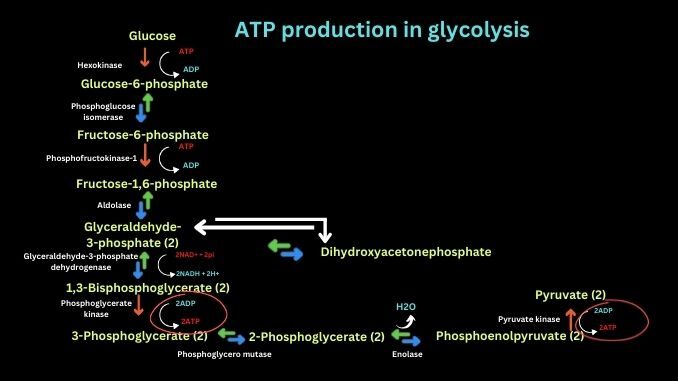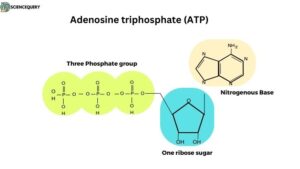
ATP is the energy currency of the cell. That is to survive and sustain we need ATP to run the vitals of the body. ATP production in glycolysis in glycolysis happens in two steps which is described as below.
Adenosine triphosphate (ATP) is a unique and the most important high-energy molecule in living cells. It consists of three parts
a. Adenine
b. Ribose
c. Triphosphate moiety.

The first step of ATP production in glycolysis
- ATP is a high-energy compound due to the presence of two Phosphoanhydride bonds in the triphosphate unit.
- ATP is formed in glycolysis by the conversion of glyceraldehyde-3-Phosphate to 3-phosphoglycerate
- The overall reaction is the oxidation of an aldehyde to a carboxylic acid. It is found in two steps and catalyzed by two different enzymes.
- The first enzyme of this reaction is nicotinamide adenine dinucleotide called NAD, these enzymes require a nonprotein cofactor. NAD plays an important role in cellular respiration by accepting and donating electrons.
- The first reaction is an oxidation-reduction reaction in which two electrons and a proton are transferred from glyceraldehyde 3-Phosphate to NAD+.
- In there Glyceraldehyde 3-Phosphate is oxidized and NAD becomes reduced. The reduced form of NAD is NADPH. The enzyme that catalyzes this reaction is glyceraldehyde 3-Phosphate dehydrogenase.
- The NAD molecule is derived from the niacin enzyme and loosely associated with the dehydrogenase enzyme in position to accept both electrons and protons (equivalent to hydride ions). The NADPH formed in this reaction is then released from the enzyme for a new molecule of NAD+.
- NADPH is a high-energy molecule, able to transfer electrons to other electrons affecting molecules.
- In the second step, a phosphate group is transferred from 1,3-bisphosphoglycerate to ADP to form a molecule of ATP.
- Phosphoglycerate kinase catalyzed this reaction.
- ATP formation is referred to as first substrate-level Phosphorylation because a phosphate group is transferred from one of the substrates to ADP.
The second step of ATP production in glycolysis
- The remaining reactions of glycolysis (steps 8−10), including a second substrate-level phosphorylation of ADP (step 10).
- The substrate-level phosphorylation of ADP illustrates an Important point about ATP.
- Its formation is not that endergonic. In other words, ATP can be readily formed by metabolic reactions.
- Two molecules of ATP are produced by substrate-level phosphorylation during glycolysis from each molecule of glyceraldehyde 3-phosphate oxidized to pyruvate.
- Because each molecule of glucose Produces two molecules of glyceraldehyde 3-phosphate, four ATP Molecules are generated per molecule of glucose oxidized to pyruvate.
- On the other hand, two molecules of ATP must be hydrolyzed To initiate glycolysis, leaving a net profit for the cell of two molecules of ATP per glucose oxidized.
Glucose + 2 ADP + 2Pi + 2 NAD → Pyruvate + 2 ATP + 2 NADH + 2H+ + 2 H2O
In short ATP production in glycolysis, happens in two steps
- When glyceraldehyde-3-phosphate → 1,3 diphosphoglycerate two molecules of ATP produced
- Another two molecules of ATP are produced when phosphoenolpyruvate → pyruvate.
- These reactions occur twice for both molecules of 3-phosphate. Thus, a total of 4 ATPs are produced during glycolysis.
Written By: Richa Pachori
